BM522 Project Management: Transport for London Project Plan 2021
VerifiedAdded on 2023/06/17
|15
|2040
|253
Report
AI Summary
This report presents a project management plan for Transport for London, focusing on the development of safer, greener, and more attractive streets. It includes a business case outlining project objectives, benefits, and drawbacks, along with a network diagram illustrating project timelines. The report also features a stakeholder analysis to identify key stakeholders and their influence, a work breakdown structure to organize project tasks, and a risk analysis to address potential challenges. Furthermore, it details quality expectations, specifications, and acceptance criteria for the project. The plan aims to enhance the bus network across London, celebrate the 40th anniversary of the G&S Society, and align with TfL's strategic direction.
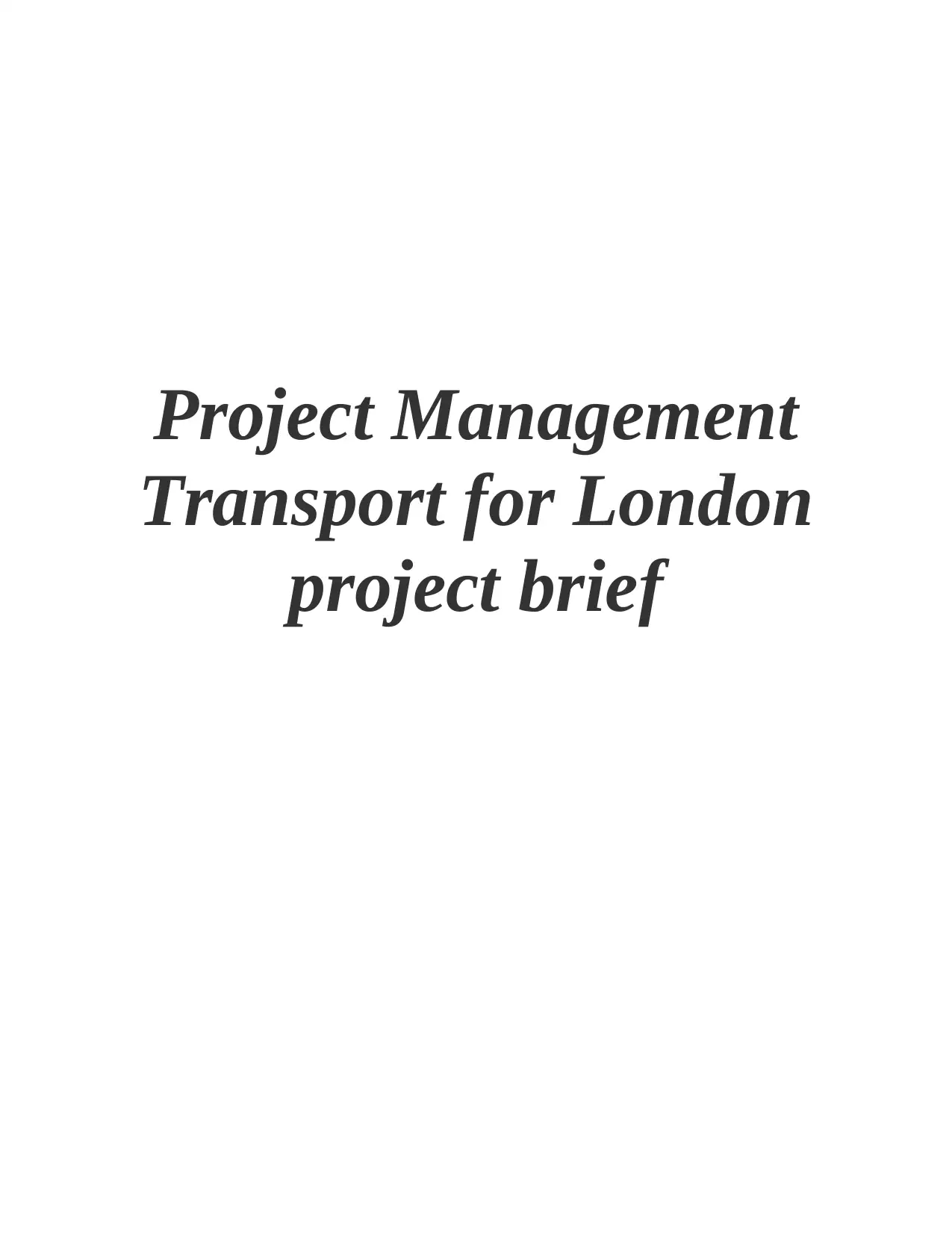
Project Management
Transport for London
project brief
Transport for London
project brief
Paraphrase This Document
Need a fresh take? Get an instant paraphrase of this document with our AI Paraphraser

Executive summary:
Project management is the process of managing and organising activities of event in efficient
manner for attaining determined goals and objectives. In this report transport of London is taken
that is involved in constructing greener, safer and sustain roads. In this report various
measurement tools and work break-down structure is explained.
Project management is the process of managing and organising activities of event in efficient
manner for attaining determined goals and objectives. In this report transport of London is taken
that is involved in constructing greener, safer and sustain roads. In this report various
measurement tools and work break-down structure is explained.
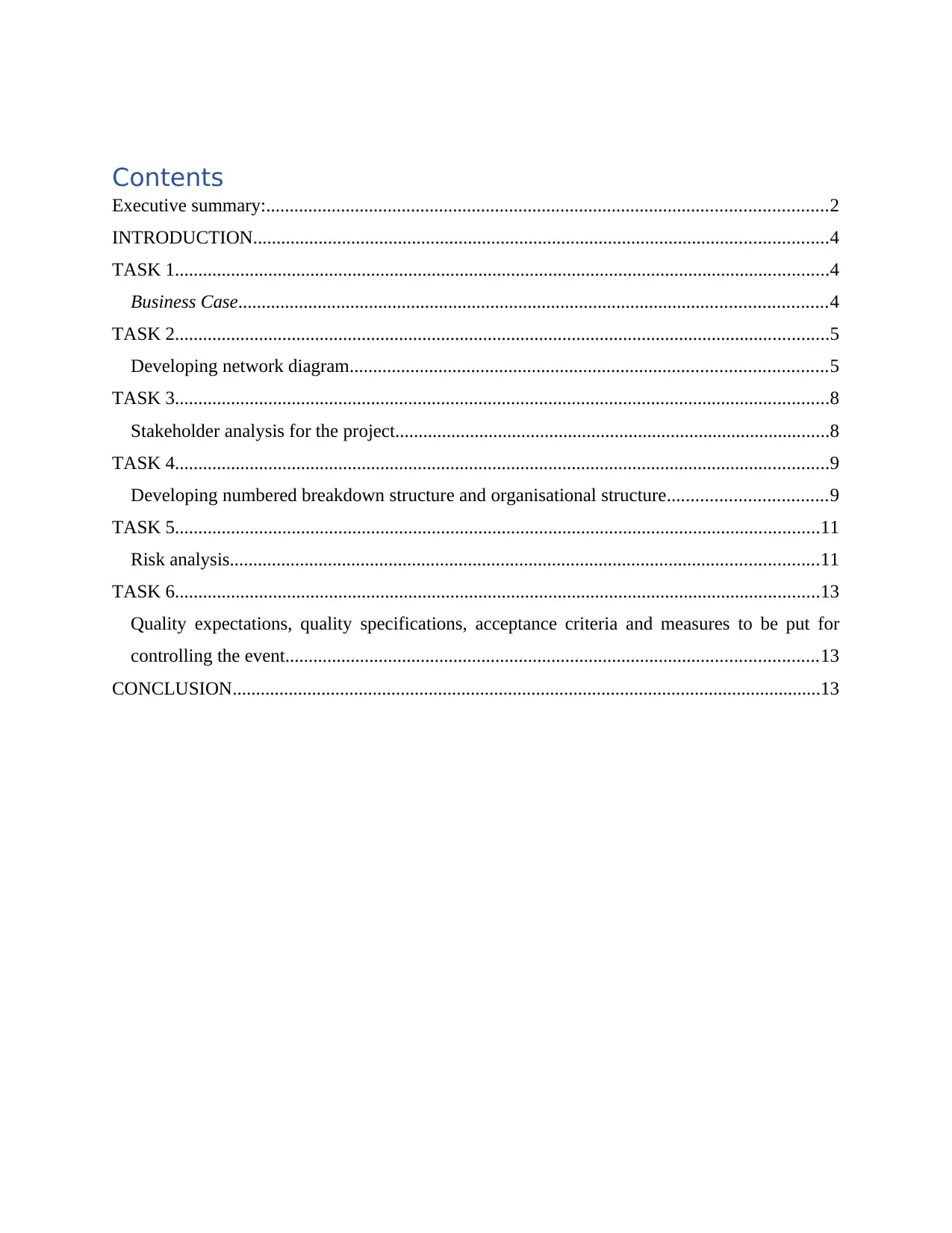
Contents
Executive summary:........................................................................................................................2
INTRODUCTION...........................................................................................................................4
TASK 1............................................................................................................................................4
Business Case..............................................................................................................................4
TASK 2............................................................................................................................................5
Developing network diagram......................................................................................................5
TASK 3............................................................................................................................................8
Stakeholder analysis for the project.............................................................................................8
TASK 4............................................................................................................................................9
Developing numbered breakdown structure and organisational structure..................................9
TASK 5..........................................................................................................................................11
Risk analysis..............................................................................................................................11
TASK 6..........................................................................................................................................13
Quality expectations, quality specifications, acceptance criteria and measures to be put for
controlling the event..................................................................................................................13
CONCLUSION..............................................................................................................................13
Executive summary:........................................................................................................................2
INTRODUCTION...........................................................................................................................4
TASK 1............................................................................................................................................4
Business Case..............................................................................................................................4
TASK 2............................................................................................................................................5
Developing network diagram......................................................................................................5
TASK 3............................................................................................................................................8
Stakeholder analysis for the project.............................................................................................8
TASK 4............................................................................................................................................9
Developing numbered breakdown structure and organisational structure..................................9
TASK 5..........................................................................................................................................11
Risk analysis..............................................................................................................................11
TASK 6..........................................................................................................................................13
Quality expectations, quality specifications, acceptance criteria and measures to be put for
controlling the event..................................................................................................................13
CONCLUSION..............................................................................................................................13
⊘ This is a preview!⊘
Do you want full access?
Subscribe today to unlock all pages.

Trusted by 1+ million students worldwide
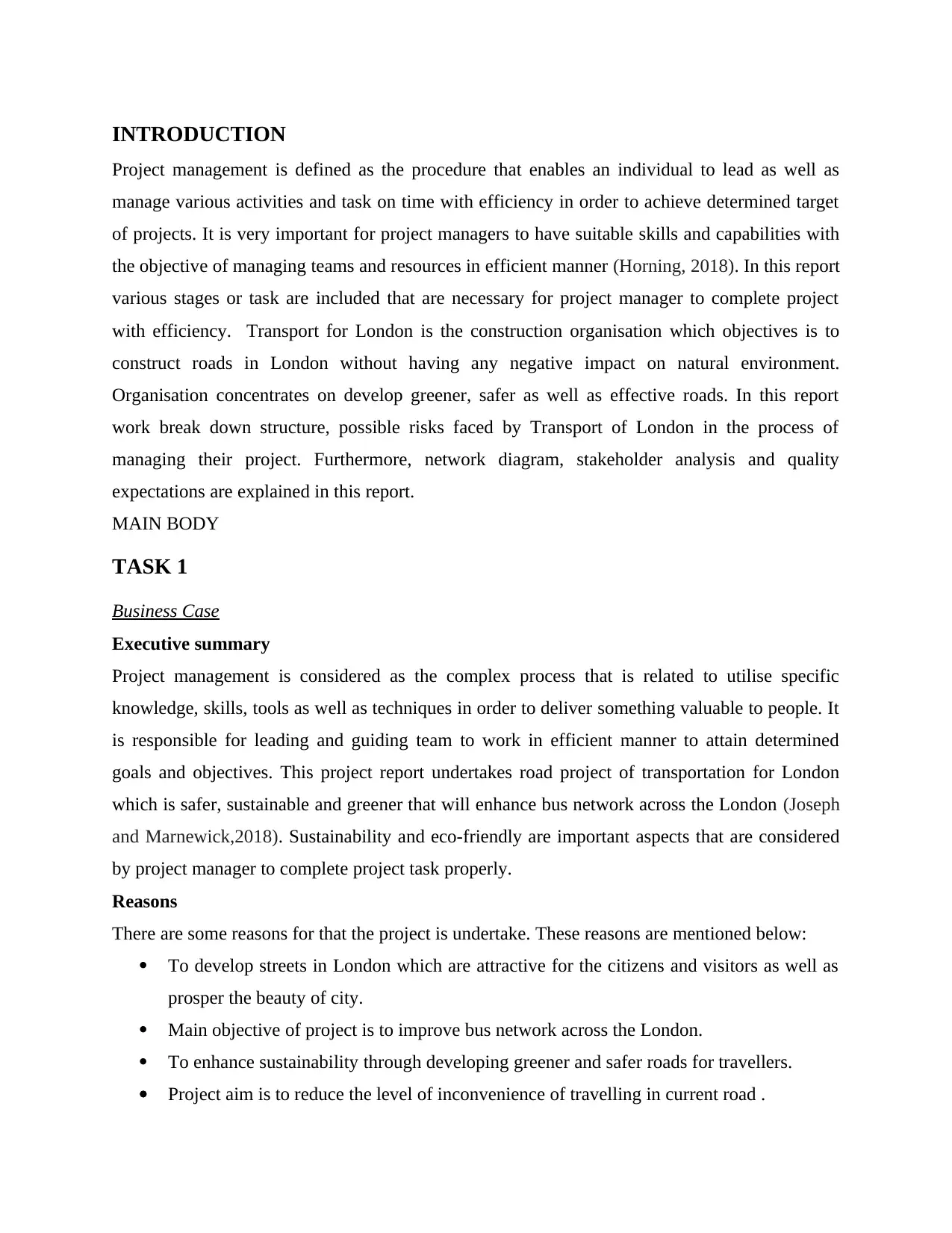
INTRODUCTION
Project management is defined as the procedure that enables an individual to lead as well as
manage various activities and task on time with efficiency in order to achieve determined target
of projects. It is very important for project managers to have suitable skills and capabilities with
the objective of managing teams and resources in efficient manner (Horning, 2018). In this report
various stages or task are included that are necessary for project manager to complete project
with efficiency. Transport for London is the construction organisation which objectives is to
construct roads in London without having any negative impact on natural environment.
Organisation concentrates on develop greener, safer as well as effective roads. In this report
work break down structure, possible risks faced by Transport of London in the process of
managing their project. Furthermore, network diagram, stakeholder analysis and quality
expectations are explained in this report.
MAIN BODY
TASK 1
Business Case
Executive summary
Project management is considered as the complex process that is related to utilise specific
knowledge, skills, tools as well as techniques in order to deliver something valuable to people. It
is responsible for leading and guiding team to work in efficient manner to attain determined
goals and objectives. This project report undertakes road project of transportation for London
which is safer, sustainable and greener that will enhance bus network across the London (Joseph
and Marnewick,2018). Sustainability and eco-friendly are important aspects that are considered
by project manager to complete project task properly.
Reasons
There are some reasons for that the project is undertake. These reasons are mentioned below:
To develop streets in London which are attractive for the citizens and visitors as well as
prosper the beauty of city.
Main objective of project is to improve bus network across the London.
To enhance sustainability through developing greener and safer roads for travellers.
Project aim is to reduce the level of inconvenience of travelling in current road .
Project management is defined as the procedure that enables an individual to lead as well as
manage various activities and task on time with efficiency in order to achieve determined target
of projects. It is very important for project managers to have suitable skills and capabilities with
the objective of managing teams and resources in efficient manner (Horning, 2018). In this report
various stages or task are included that are necessary for project manager to complete project
with efficiency. Transport for London is the construction organisation which objectives is to
construct roads in London without having any negative impact on natural environment.
Organisation concentrates on develop greener, safer as well as effective roads. In this report
work break down structure, possible risks faced by Transport of London in the process of
managing their project. Furthermore, network diagram, stakeholder analysis and quality
expectations are explained in this report.
MAIN BODY
TASK 1
Business Case
Executive summary
Project management is considered as the complex process that is related to utilise specific
knowledge, skills, tools as well as techniques in order to deliver something valuable to people. It
is responsible for leading and guiding team to work in efficient manner to attain determined
goals and objectives. This project report undertakes road project of transportation for London
which is safer, sustainable and greener that will enhance bus network across the London (Joseph
and Marnewick,2018). Sustainability and eco-friendly are important aspects that are considered
by project manager to complete project task properly.
Reasons
There are some reasons for that the project is undertake. These reasons are mentioned below:
To develop streets in London which are attractive for the citizens and visitors as well as
prosper the beauty of city.
Main objective of project is to improve bus network across the London.
To enhance sustainability through developing greener and safer roads for travellers.
Project aim is to reduce the level of inconvenience of travelling in current road .
Paraphrase This Document
Need a fresh take? Get an instant paraphrase of this document with our AI Paraphraser
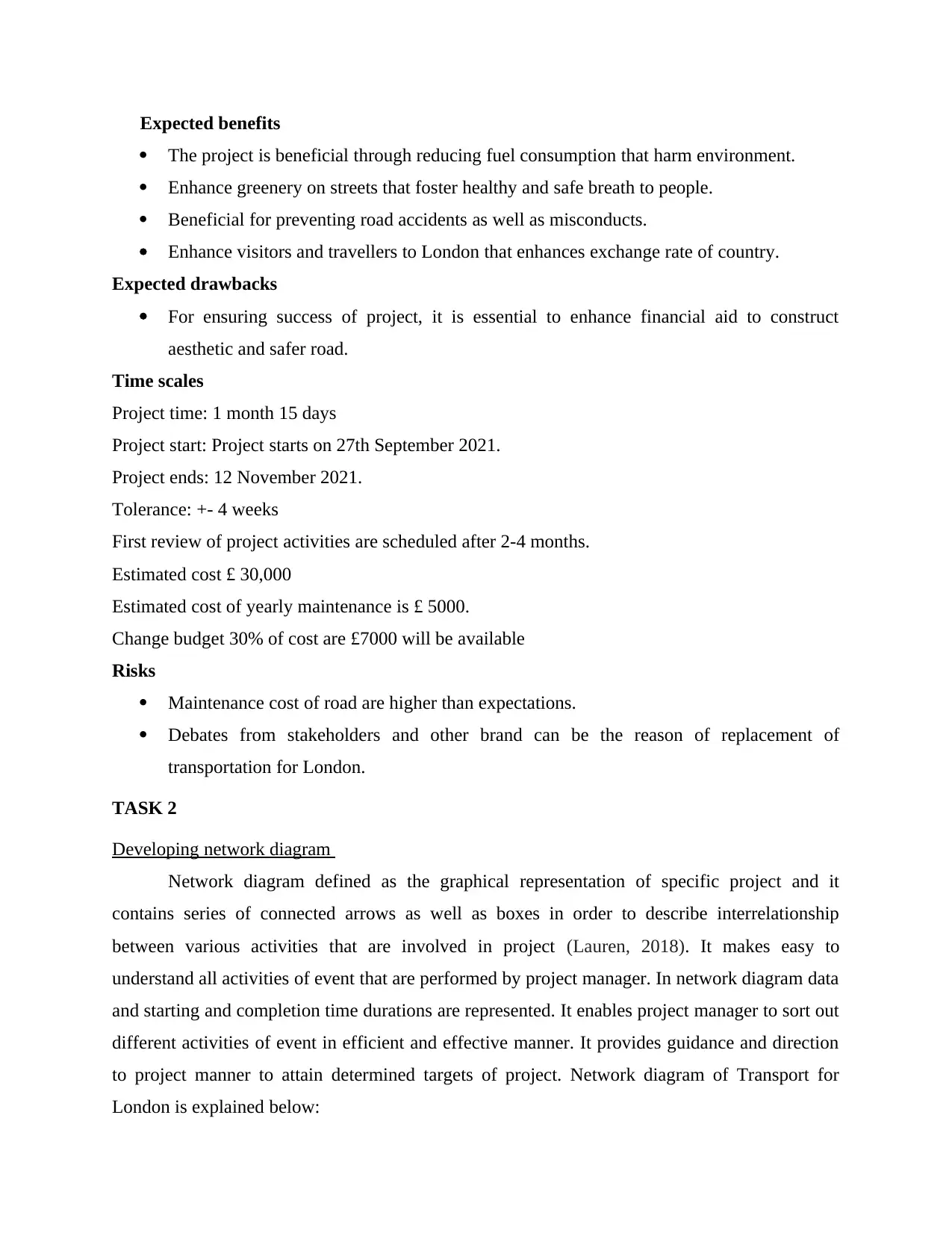
Expected benefits
The project is beneficial through reducing fuel consumption that harm environment.
Enhance greenery on streets that foster healthy and safe breath to people.
Beneficial for preventing road accidents as well as misconducts.
Enhance visitors and travellers to London that enhances exchange rate of country.
Expected drawbacks
For ensuring success of project, it is essential to enhance financial aid to construct
aesthetic and safer road.
Time scales
Project time: 1 month 15 days
Project start: Project starts on 27th September 2021.
Project ends: 12 November 2021.
Tolerance: +- 4 weeks
First review of project activities are scheduled after 2-4 months.
Estimated cost £ 30,000
Estimated cost of yearly maintenance is £ 5000.
Change budget 30% of cost are £7000 will be available
Risks
Maintenance cost of road are higher than expectations.
Debates from stakeholders and other brand can be the reason of replacement of
transportation for London.
TASK 2
Developing network diagram
Network diagram defined as the graphical representation of specific project and it
contains series of connected arrows as well as boxes in order to describe interrelationship
between various activities that are involved in project (Lauren, 2018). It makes easy to
understand all activities of event that are performed by project manager. In network diagram data
and starting and completion time durations are represented. It enables project manager to sort out
different activities of event in efficient and effective manner. It provides guidance and direction
to project manner to attain determined targets of project. Network diagram of Transport for
London is explained below:
The project is beneficial through reducing fuel consumption that harm environment.
Enhance greenery on streets that foster healthy and safe breath to people.
Beneficial for preventing road accidents as well as misconducts.
Enhance visitors and travellers to London that enhances exchange rate of country.
Expected drawbacks
For ensuring success of project, it is essential to enhance financial aid to construct
aesthetic and safer road.
Time scales
Project time: 1 month 15 days
Project start: Project starts on 27th September 2021.
Project ends: 12 November 2021.
Tolerance: +- 4 weeks
First review of project activities are scheduled after 2-4 months.
Estimated cost £ 30,000
Estimated cost of yearly maintenance is £ 5000.
Change budget 30% of cost are £7000 will be available
Risks
Maintenance cost of road are higher than expectations.
Debates from stakeholders and other brand can be the reason of replacement of
transportation for London.
TASK 2
Developing network diagram
Network diagram defined as the graphical representation of specific project and it
contains series of connected arrows as well as boxes in order to describe interrelationship
between various activities that are involved in project (Lauren, 2018). It makes easy to
understand all activities of event that are performed by project manager. In network diagram data
and starting and completion time durations are represented. It enables project manager to sort out
different activities of event in efficient and effective manner. It provides guidance and direction
to project manner to attain determined targets of project. Network diagram of Transport for
London is explained below:
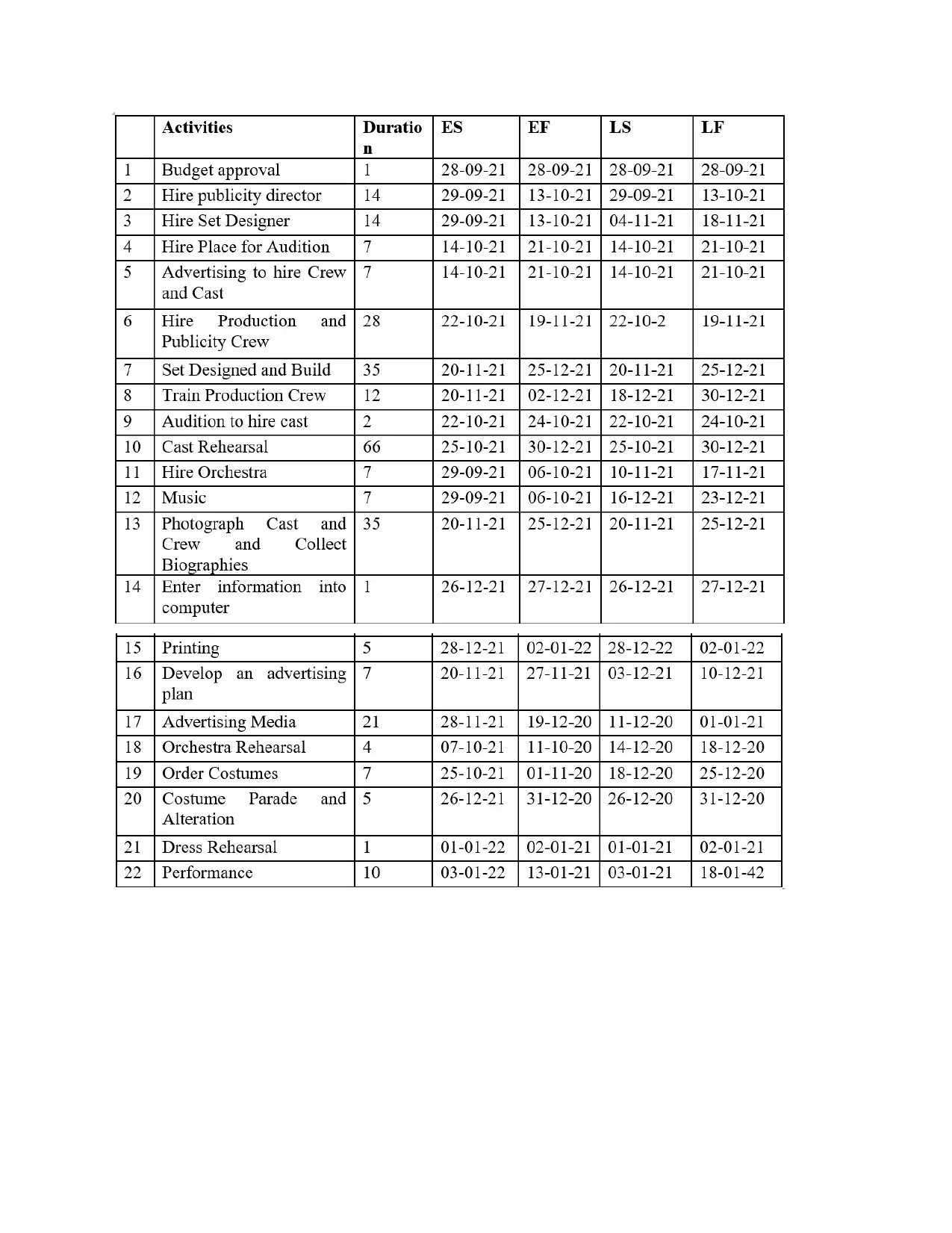
⊘ This is a preview!⊘
Do you want full access?
Subscribe today to unlock all pages.

Trusted by 1+ million students worldwide
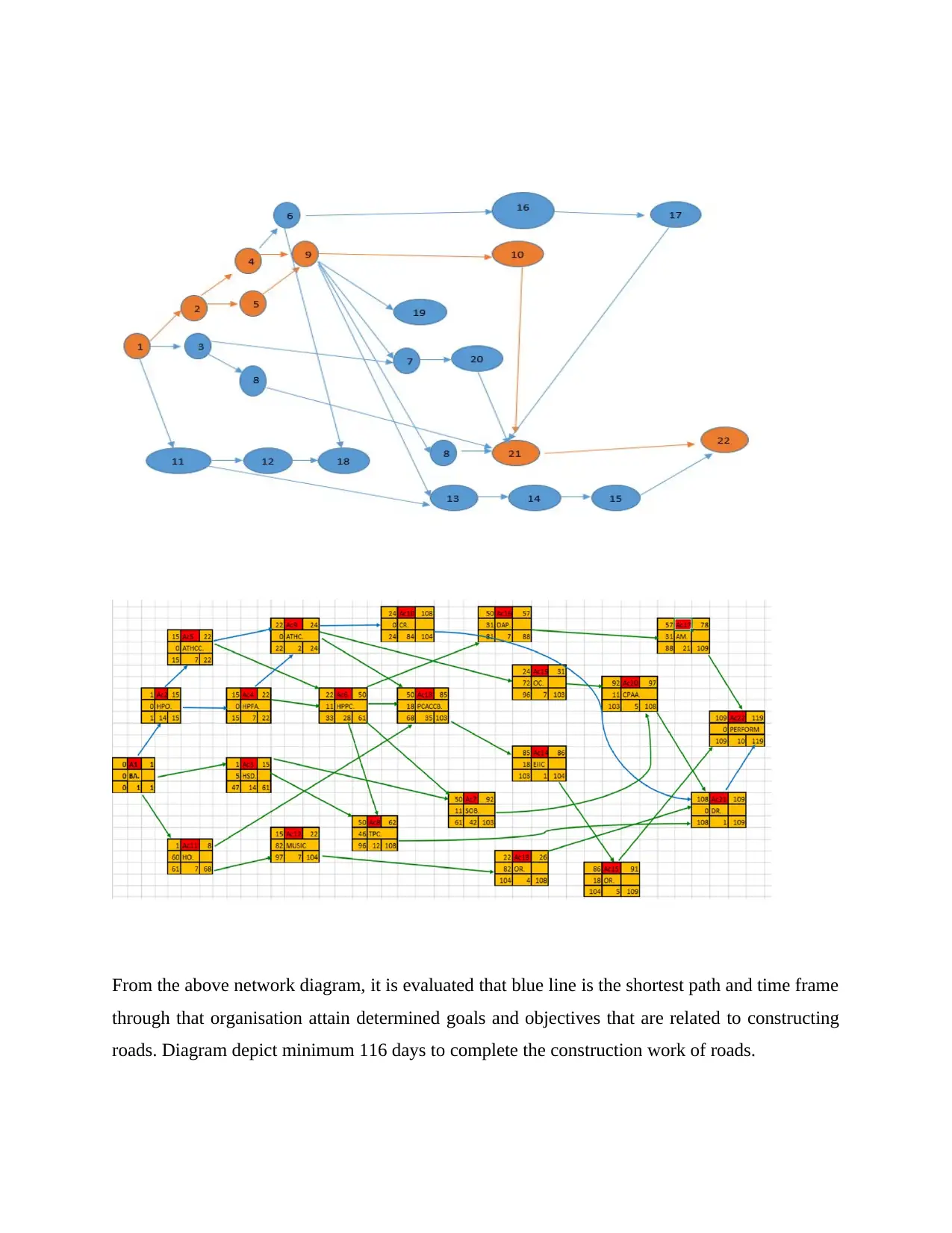
From the above network diagram, it is evaluated that blue line is the shortest path and time frame
through that organisation attain determined goals and objectives that are related to constructing
roads. Diagram depict minimum 116 days to complete the construction work of roads.
through that organisation attain determined goals and objectives that are related to constructing
roads. Diagram depict minimum 116 days to complete the construction work of roads.
Paraphrase This Document
Need a fresh take? Get an instant paraphrase of this document with our AI Paraphraser
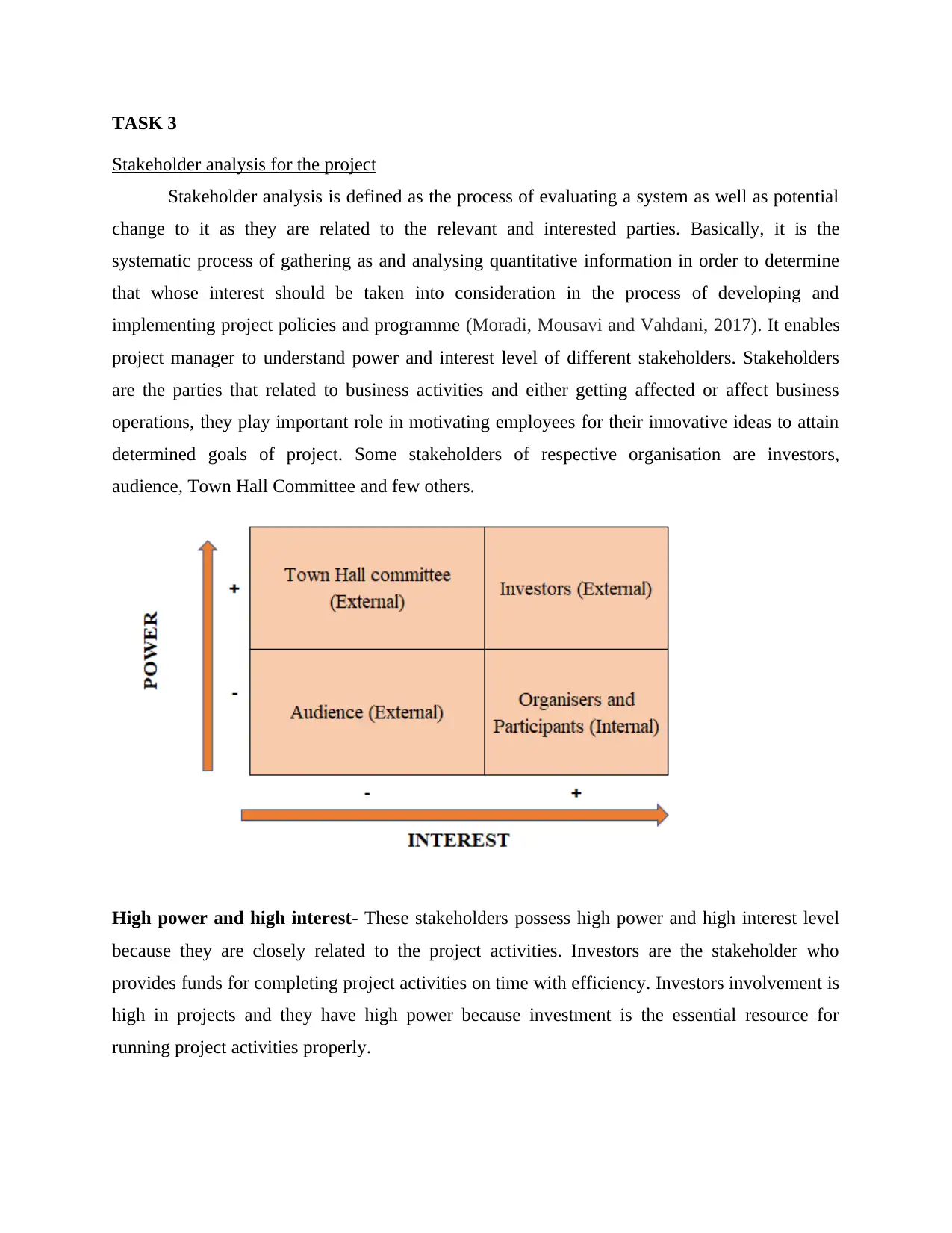
TASK 3
Stakeholder analysis for the project
Stakeholder analysis is defined as the process of evaluating a system as well as potential
change to it as they are related to the relevant and interested parties. Basically, it is the
systematic process of gathering as and analysing quantitative information in order to determine
that whose interest should be taken into consideration in the process of developing and
implementing project policies and programme (Moradi, Mousavi and Vahdani, 2017). It enables
project manager to understand power and interest level of different stakeholders. Stakeholders
are the parties that related to business activities and either getting affected or affect business
operations, they play important role in motivating employees for their innovative ideas to attain
determined goals of project. Some stakeholders of respective organisation are investors,
audience, Town Hall Committee and few others.
High power and high interest- These stakeholders possess high power and high interest level
because they are closely related to the project activities. Investors are the stakeholder who
provides funds for completing project activities on time with efficiency. Investors involvement is
high in projects and they have high power because investment is the essential resource for
running project activities properly.
Stakeholder analysis for the project
Stakeholder analysis is defined as the process of evaluating a system as well as potential
change to it as they are related to the relevant and interested parties. Basically, it is the
systematic process of gathering as and analysing quantitative information in order to determine
that whose interest should be taken into consideration in the process of developing and
implementing project policies and programme (Moradi, Mousavi and Vahdani, 2017). It enables
project manager to understand power and interest level of different stakeholders. Stakeholders
are the parties that related to business activities and either getting affected or affect business
operations, they play important role in motivating employees for their innovative ideas to attain
determined goals of project. Some stakeholders of respective organisation are investors,
audience, Town Hall Committee and few others.
High power and high interest- These stakeholders possess high power and high interest level
because they are closely related to the project activities. Investors are the stakeholder who
provides funds for completing project activities on time with efficiency. Investors involvement is
high in projects and they have high power because investment is the essential resource for
running project activities properly.
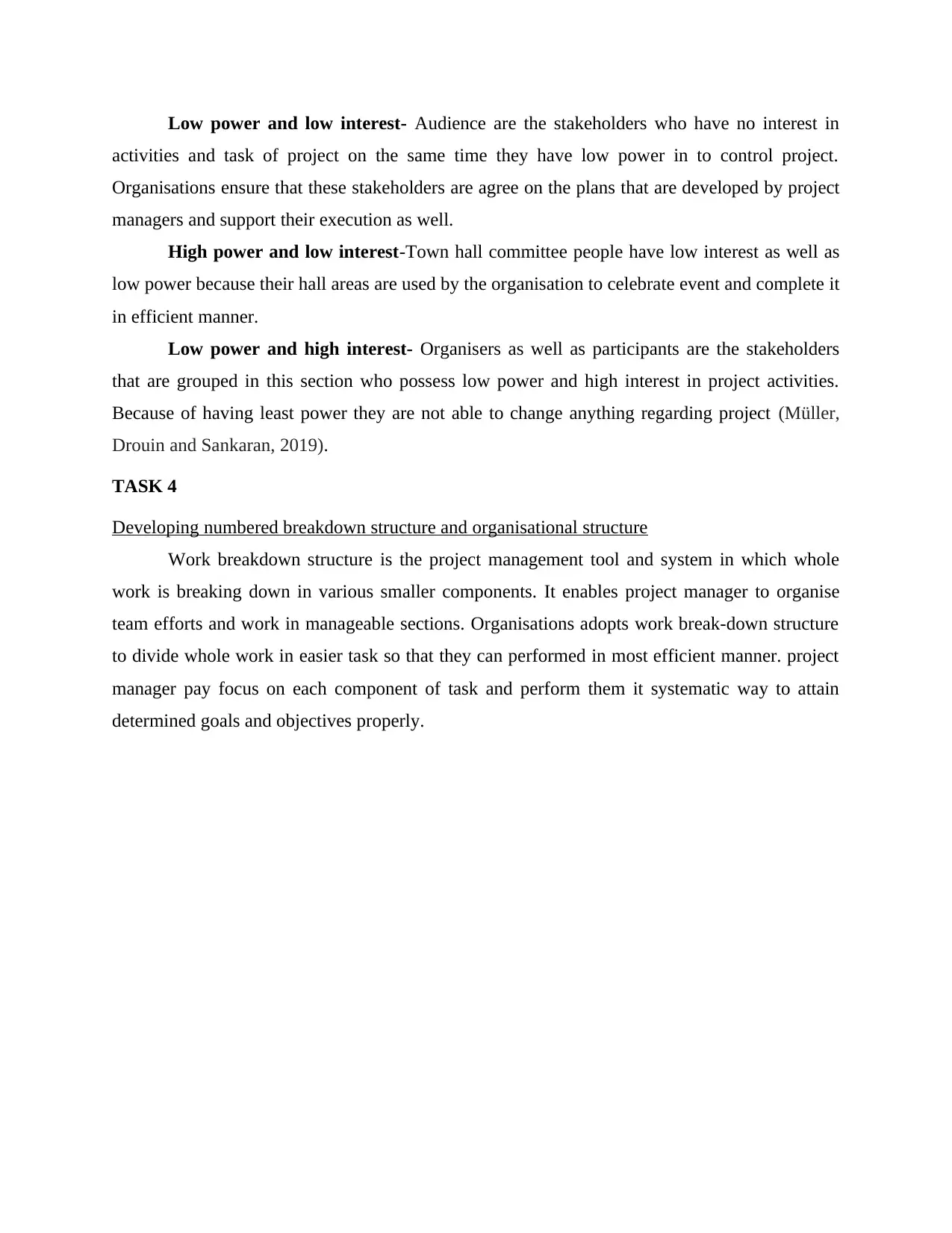
Low power and low interest- Audience are the stakeholders who have no interest in
activities and task of project on the same time they have low power in to control project.
Organisations ensure that these stakeholders are agree on the plans that are developed by project
managers and support their execution as well.
High power and low interest-Town hall committee people have low interest as well as
low power because their hall areas are used by the organisation to celebrate event and complete it
in efficient manner.
Low power and high interest- Organisers as well as participants are the stakeholders
that are grouped in this section who possess low power and high interest in project activities.
Because of having least power they are not able to change anything regarding project (Müller,
Drouin and Sankaran, 2019).
TASK 4
Developing numbered breakdown structure and organisational structure
Work breakdown structure is the project management tool and system in which whole
work is breaking down in various smaller components. It enables project manager to organise
team efforts and work in manageable sections. Organisations adopts work break-down structure
to divide whole work in easier task so that they can performed in most efficient manner. project
manager pay focus on each component of task and perform them it systematic way to attain
determined goals and objectives properly.
activities and task of project on the same time they have low power in to control project.
Organisations ensure that these stakeholders are agree on the plans that are developed by project
managers and support their execution as well.
High power and low interest-Town hall committee people have low interest as well as
low power because their hall areas are used by the organisation to celebrate event and complete it
in efficient manner.
Low power and high interest- Organisers as well as participants are the stakeholders
that are grouped in this section who possess low power and high interest in project activities.
Because of having least power they are not able to change anything regarding project (Müller,
Drouin and Sankaran, 2019).
TASK 4
Developing numbered breakdown structure and organisational structure
Work breakdown structure is the project management tool and system in which whole
work is breaking down in various smaller components. It enables project manager to organise
team efforts and work in manageable sections. Organisations adopts work break-down structure
to divide whole work in easier task so that they can performed in most efficient manner. project
manager pay focus on each component of task and perform them it systematic way to attain
determined goals and objectives properly.
⊘ This is a preview!⊘
Do you want full access?
Subscribe today to unlock all pages.

Trusted by 1+ million students worldwide
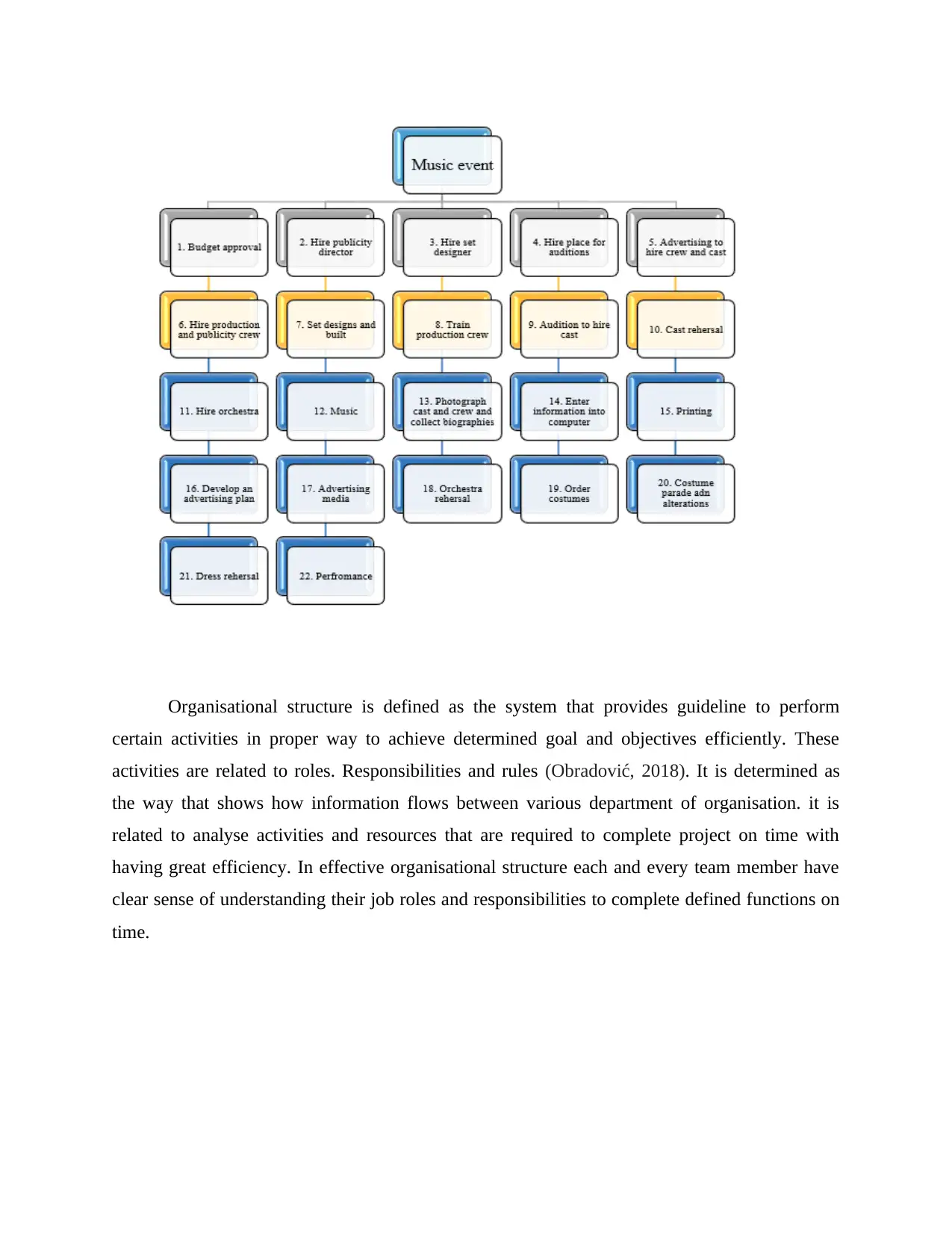
Organisational structure is defined as the system that provides guideline to perform
certain activities in proper way to achieve determined goal and objectives efficiently. These
activities are related to roles. Responsibilities and rules (Obradović, 2018). It is determined as
the way that shows how information flows between various department of organisation. it is
related to analyse activities and resources that are required to complete project on time with
having great efficiency. In effective organisational structure each and every team member have
clear sense of understanding their job roles and responsibilities to complete defined functions on
time.
certain activities in proper way to achieve determined goal and objectives efficiently. These
activities are related to roles. Responsibilities and rules (Obradović, 2018). It is determined as
the way that shows how information flows between various department of organisation. it is
related to analyse activities and resources that are required to complete project on time with
having great efficiency. In effective organisational structure each and every team member have
clear sense of understanding their job roles and responsibilities to complete defined functions on
time.
Paraphrase This Document
Need a fresh take? Get an instant paraphrase of this document with our AI Paraphraser
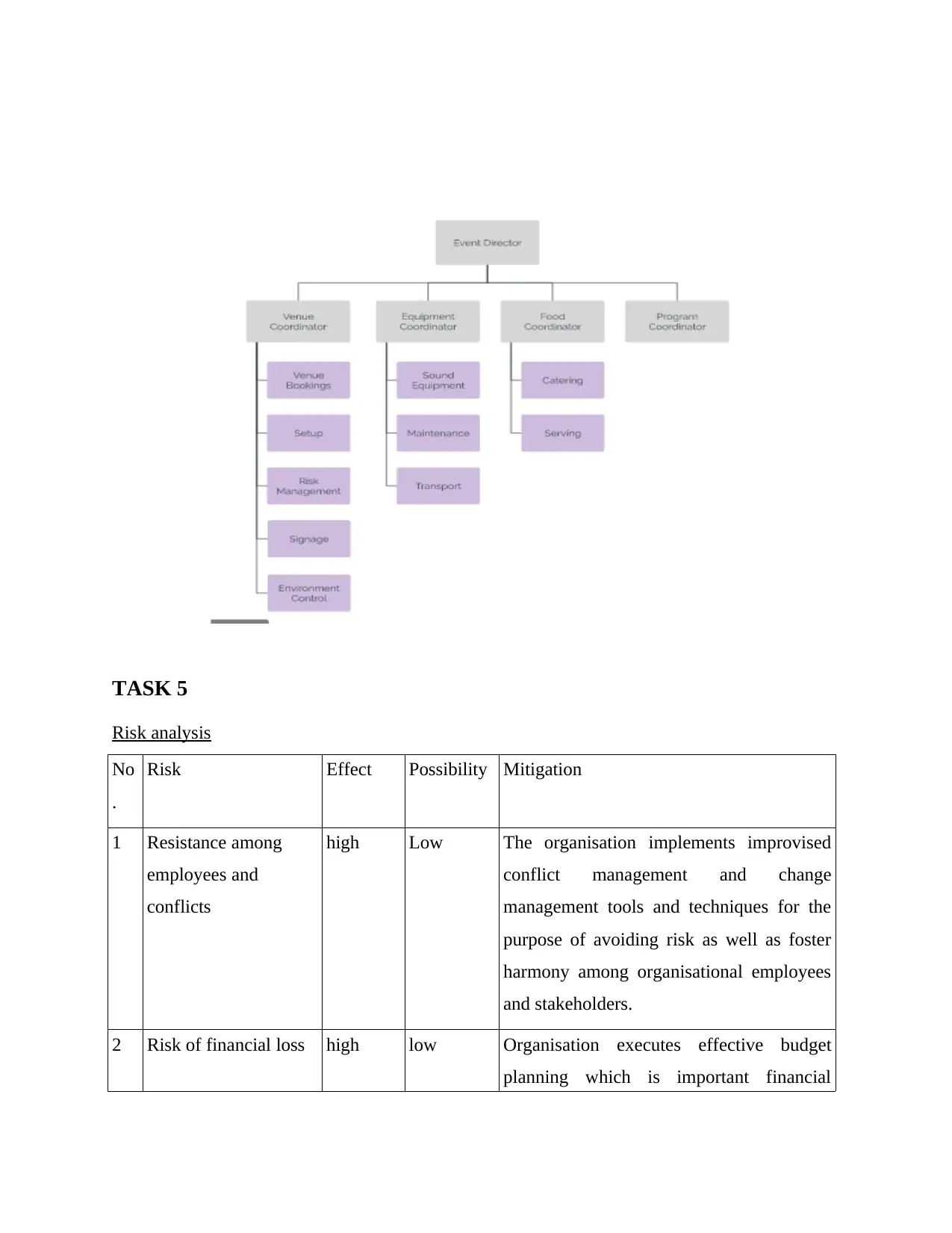
TASK 5
Risk analysis
No
.
Risk Effect Possibility Mitigation
1 Resistance among
employees and
conflicts
high Low The organisation implements improvised
conflict management and change
management tools and techniques for the
purpose of avoiding risk as well as foster
harmony among organisational employees
and stakeholders.
2 Risk of financial loss high low Organisation executes effective budget
planning which is important financial
Risk analysis
No
.
Risk Effect Possibility Mitigation
1 Resistance among
employees and
conflicts
high Low The organisation implements improvised
conflict management and change
management tools and techniques for the
purpose of avoiding risk as well as foster
harmony among organisational employees
and stakeholders.
2 Risk of financial loss high low Organisation executes effective budget
planning which is important financial
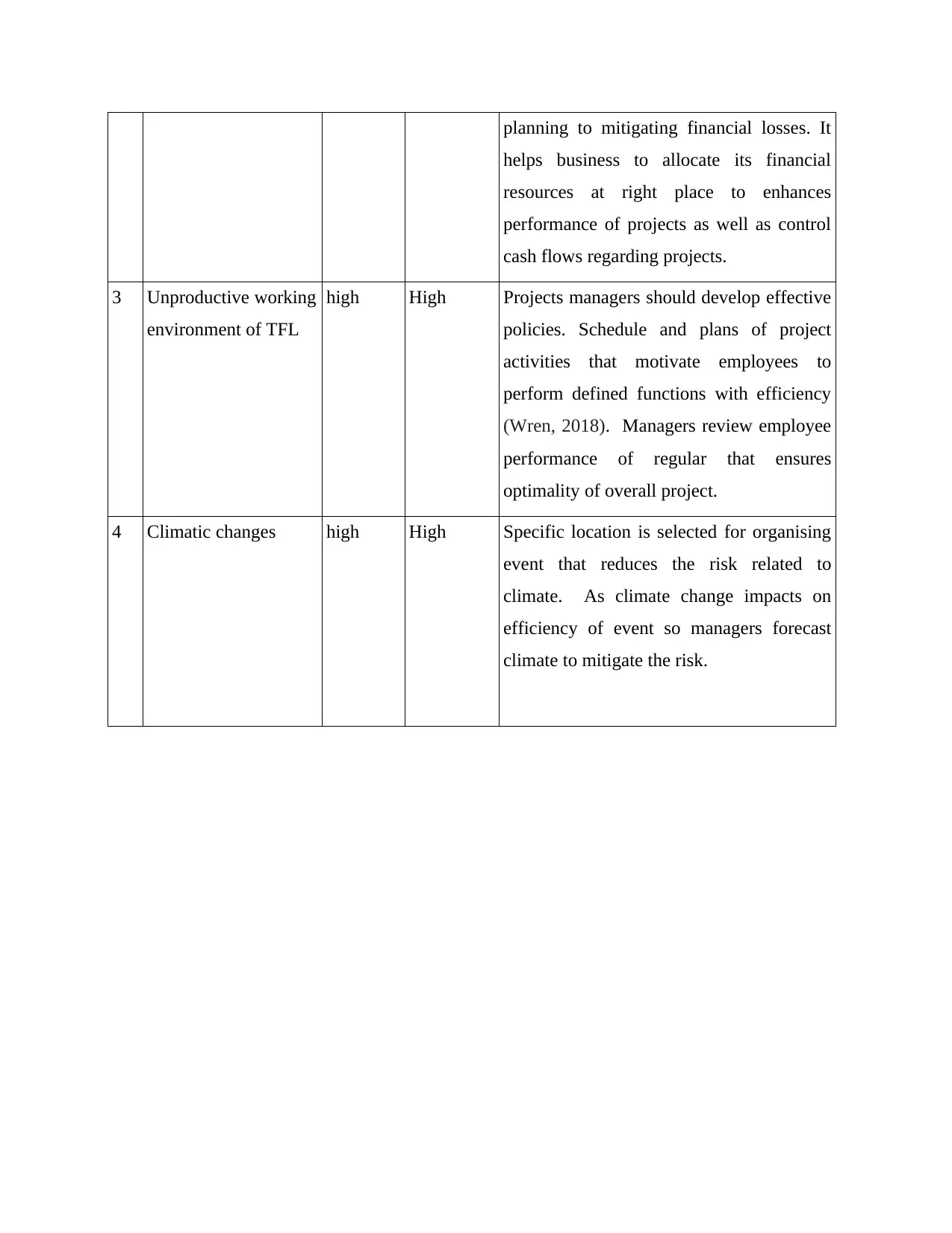
planning to mitigating financial losses. It
helps business to allocate its financial
resources at right place to enhances
performance of projects as well as control
cash flows regarding projects.
3 Unproductive working
environment of TFL
high High Projects managers should develop effective
policies. Schedule and plans of project
activities that motivate employees to
perform defined functions with efficiency
(Wren, 2018). Managers review employee
performance of regular that ensures
optimality of overall project.
4 Climatic changes high High Specific location is selected for organising
event that reduces the risk related to
climate. As climate change impacts on
efficiency of event so managers forecast
climate to mitigate the risk.
helps business to allocate its financial
resources at right place to enhances
performance of projects as well as control
cash flows regarding projects.
3 Unproductive working
environment of TFL
high High Projects managers should develop effective
policies. Schedule and plans of project
activities that motivate employees to
perform defined functions with efficiency
(Wren, 2018). Managers review employee
performance of regular that ensures
optimality of overall project.
4 Climatic changes high High Specific location is selected for organising
event that reduces the risk related to
climate. As climate change impacts on
efficiency of event so managers forecast
climate to mitigate the risk.
⊘ This is a preview!⊘
Do you want full access?
Subscribe today to unlock all pages.

Trusted by 1+ million students worldwide
1 out of 15
Related Documents
Your All-in-One AI-Powered Toolkit for Academic Success.
+13062052269
info@desklib.com
Available 24*7 on WhatsApp / Email
![[object Object]](/_next/static/media/star-bottom.7253800d.svg)
Unlock your academic potential
Copyright © 2020–2025 A2Z Services. All Rights Reserved. Developed and managed by ZUCOL.


